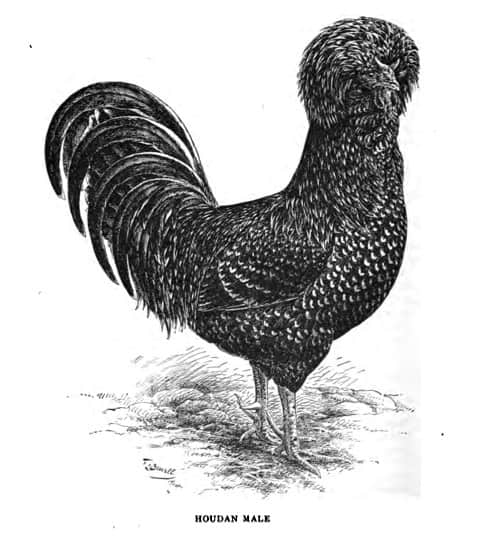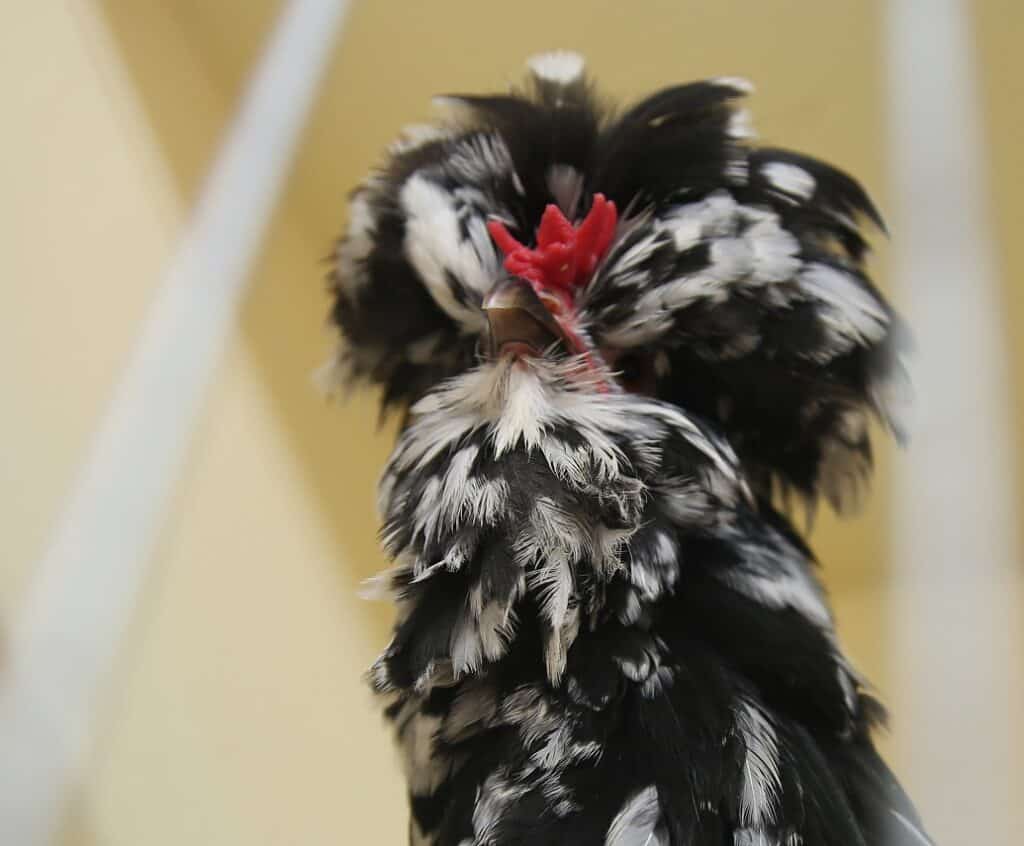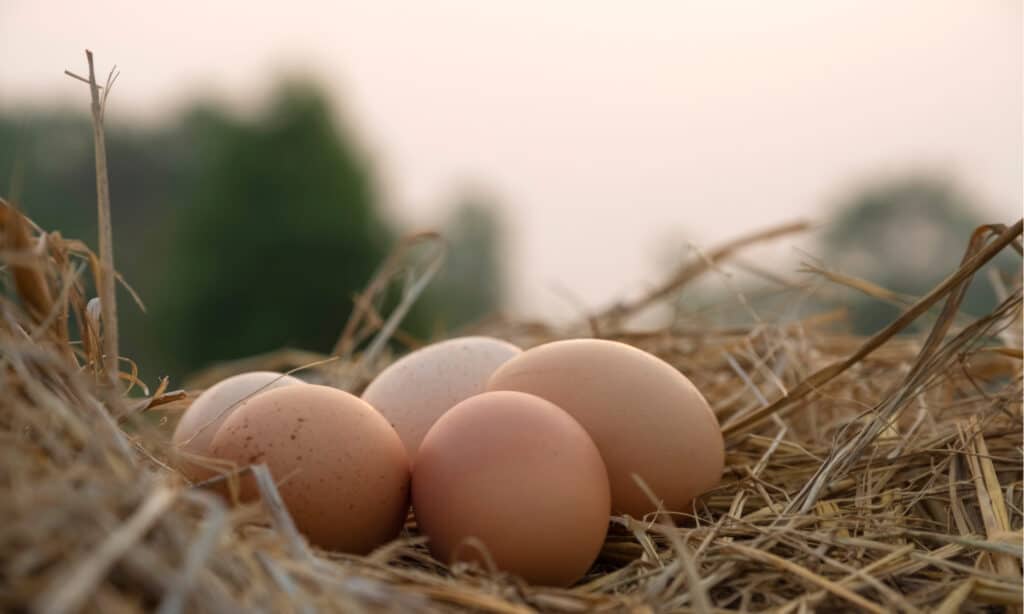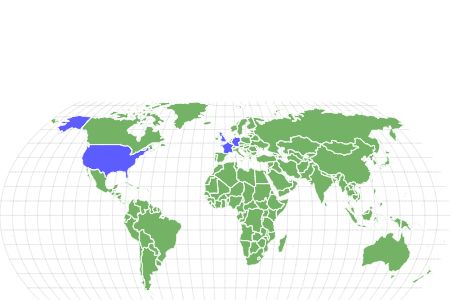The Houdan chicken has a round, fluffy crest and five toes on each foot!
Advertisement
Houdan Chicken Scientific Classification
- Kingdom
- Animalia
- Phylum
- Chordata
- Class
- Aves
- Order
- Galliformes
- Family
- Phasianidae
- Genus
- Gallus
- Scientific Name
- Gallus gallus
Read our Complete Guide to Classification of Animals.
Houdan Chicken Conservation Status
Houdan Chicken Facts
- Prey
- Insects, worms, other invertebrates
- Main Prey
- Insects
- Name Of Young
- Chicks
- Group Behavior
- Flock
- Fun Fact
- The Houdan chicken has a round, fluffy crest and five toes on each foot!
- Estimated Population Size
- Fewer than 5000 worldwide
- Most Distinctive Feature
- Large, round crest, muff and beard
- Distinctive Feature
- Red leaf-shaped or v-shaped comb; Feet with five toes; Large nostrils; Long, arched tail feathers
- Other Name(s)
- Poule de Houdan
- Habitat
- Captivity
- Diet
- Omnivore
- Lifestyle
- Diurnal
- Flock
- Favorite Food
- Insects
Houdan Chicken Physical Characteristics
- Color
- Grey
- Black
- White
- Skin Type
- Feathers
- Lifespan
- 7 to 8 years
- Weight
- 6.5 to 8 pounds
- Age of Sexual Maturity
- 22 weeks
- Venomous
- No
- Aggression
- Low
View all of the Houdan Chicken images!
The Houdan chicken has a lot going on. It has a prominent, round, fluffy crest, full muffs, and a beard. It also has five toes on each foot instead of the usual four. Add to that a distinctive comb that looks a lot like a red butterfly sitting on top of its head, and a perky arched tail, and you have quite the picture. For all its unusual traits, the Houdan chicken is an amiable bird. In fact, owners say that the hens actually enjoy being cuddled. This once-popular breed is on its way back from near extinction just a few years ago.
Incredible Houdan Chicken Facts

- The Houdan chicken is a crested bird similar to the Crèvecoeur and Polish chickens, but with five toes instead of four
- This ancient bird has been around as early as the Roman empire
- These chickens earned the Label Rouge in France for their exceptional meat
- Houdan chickens have trouble seeing due to the size and fullness of their crests
- These chickens do not do well in cold, wet climates because their crests can freeze
- This breed is known as Poule de Houdan in its native France
Where to Find Houdan Chickens
Houdan chickens originated in France around 2,000 years ago. Their name derives from the small town of Houdan, which is about 63 kilometers, or 39 miles, west of Paris. Scientists believe residents from the small town originally bred the Houdan chicken from ancient five-toed fowl that were indigenous to the area. The chicken thrived in France for centuries before the advent of mass commercial farming.
According to researchers at the Slow Food Foundation for Biodiversity, the Houdan chicken was a popular bird served at the tables of the royal court during the time of Louis XIII. The chicken was easy to fatten and had exceptional meat quality, both of which caused its popularity to soar.
Demand for the Houdan chicken increased. It was introduced in England in the 1850s and in the United States in 1865. By the early 1870s, records show that at least 600,000 birds per year were sold. Bantam varieties were developed in Germany and France after World War II.
Today, the Houdan chicken is slowly recovering from near extinction. In the early part of the 21st century, fewer than 1,000 of these chickens remained worldwide, placing them on the Livestock Conservancy critical list. Lack of demand for the Houdan chicken, due to emphasis on mass commercial farm breeds, nearly caused it to die out. Thanks to the work of conservationists, it can still be found in France, the United States, Britain, and other locations, mainly in small flocks.
Houdan Chicken Scientific Name
The Houdan chicken, or Poule de Houdan as it is known in France, was named after the small town where it originated. It was first described by a French painter named Charles Jacque in 1856. The bird’s scientific name is Gallus gallus or Gallus gallus domesticus, just like other domesticated chickens around the world. The red junglefowl of South and Southeast Asia, G. gallus, was named by Linnaeus in 1758. Today dozens of different breeds comprise the Gallus gallus domesticus species.
Houdan Chicken Appearance

©https://www.flickr.com/photos/54516384@N02/44396714031/ – License
The Houdan chicken is a distinctive bird with a large, round crest complete with muffs and a beard. It looks like it is wearing a huge, feathered headdress. This impressive crest is so full that it usually conceals the bird’s white earlobes and small wattle. Sometimes owners have to trim back the feathers around the chicken’s face so that it can see to move around.
The bird’s beak is either pinkish-white or horn colored and features wide nostrils. These chickens have red combs with a particular shape. They are described as V-shaped in the United States and leaf-shaped in Europe. The comb looks similar to a red butterfly sitting atop the chicken’s head with its wings open.
Houdan chickens have short, pinkish-white legs and feet with five toes on each foot instead of the usual four. They were initially bred from ancient five-toed fowl in France. Recent genetic studies show that the polydactyly found in Houdan chickens evolved separately from that of five-toed Chinese chickens.
Houdan chickens are sexually dimorphic, with males having larger and fuller crests and more prominent combs. The males also have long tail feathers, which are arched and held erect. Males are larger than females. Roosters weigh up to 8 pounds, and hens can reach about 6.5 pounds.
Different varieties of Houdan chickens are recognized as breed standards in different countries. In the United Kingdom, only the mottled variety, with white splotches on a black background, is recognized. The American Poultry Association added the mottled variety to its list of breed standards in 1874 and recognized the white variety in 1914. It also now includes bantam varieties of each. The Houdan chicken’s native France recognizes three varieties: black, pearl-grey, and white.
Houdan Chicken Behavior
Although the Houdan chickens were initially bred for egg laying and meat production, they are now primarily ornamental or show birds. They are very friendly chickens and reportedly enjoy being cuddled. They are not aggressive and should not be kept alongside such breeds because they will be bullied.
Houdan chickens tolerate heat well and thrive best in warm and sunny environments. Because of their abundant feathers and large crests, they do not fare well in cold or excessively wet environments. If it is too cold, their crests can freeze, and the chickens can get frostbite.
These birds do not see well due to their crests and muffs. Breeders can help by providing enclosed and covered runs to reduce the risk of predation and exposure to wet weather.
Diet
Houdan chickens are adept foragers. They eat insects, worms and other invertebrates in large quantities. Breeders indicate that these chickens can fulfill most of their dietary needs through foraging if given adequate space.
Breeders must supplement their Houdan flock with commercial feed. A protein-rich diet is necessary for all birds to support the growth of their feathers. Houdan hens also need a lot of calcium because they lay between 150 to 230 large eggs yearly. In France, these chickens are fed a grain-based diet supplemented with milk and cream.
Like other chickens, Houdan chickens should not eat rhubarb, avocado pits, skins, or beans, as these can be harmful.
Houdan Chicken Reproduction

The Houdan chicken lays eggs on par with the Leghorn chicken, a breed that is a staple of the egg industry.
©ANEK SANGKAMANEE/Shutterstock.com
Because Houdan roosters can be quite ardent, breeders recommend keeping a large number of hens for each male. Some breeders suggest a ratio of about one rooster for every ten hens to satisfy the males’ tendencies without overburdening the females.
Hens lay several eggs per week, averaging between 150 and 230 per year, but some reports indicate that they can lay as many as 280. The Houdan chicken lays eggs on par with the Leghorn chicken, a breed that is a staple of the egg industry. They even lay well during the winter when many other chickens cease production. Insufficient fresh drinking water is one of the only limiting factors to this chicken’s egg-laying capabilities.
The hens reportedly tend to get broody, especially in the spring. Unfortunately, they will often sit on too many eggs at once. This behavior tends to cause the eggs to crack. Breeders can prevent this by removing some of the eggs.
Houdan chicks are available from several breeders. Because the hens lay so many eggs, owners can build a thriving flock. This breed was extremely popular in France around 150 years ago but nearly became extinct by the turn of this century. Although their numbers are still small, these chickens are beginning to recover.
Predators and Threats
Houdan chickens are medium to large chickens. Their size might help deter predators such as owls and hawks, but their impaired vision makes them susceptible to attack. Foxes also easily prey on these chickens because they can sneak up on them unseen.
Owners can help their Houdan chickens by trimming some feathers around their eyes. They can also provide safe enclosures for the birds with covered runs and fences that deter nest predators like snakes.
Parasites like mites are among the biggest threats to Houdan chickens. These chickens are particularly vulnerable to mites because of their abundant feathers, especially around their heads. Owners must keep enclosures and nesting areas clean and debris-free to reduce parasites. They should also provide nests and perches off the ground.
Moisture is the other major threat to the Houdan chicken, especially in colder climates. The chickens need lots of water to support egg production, but chronically wet feathers can lead to disease. In cold environments, wet feathers also freeze and can cause the birds to get frostbite. Owners should provide water sources that the birds can use without getting their crests wet.
Lifespan of the Houdan Chicken
Houdan chickens live around eight years on average. That is if they are not eaten first. These chickens are prized in France for their high quality in production and taste. The French government gave the Houdan chicken the Label Rouge designation for exceptional quality and the Protected Geographical Indications mark. These distinctions may increase the likelihood of individual birds becoming a gourmet dinner. However, the increased demand for the high-quality meat of the Houdan chicken improves the breed’s chances of survival overall.
Similar Animals
- Silkie Chicken – The silkie chicken is a crested chicken of Chinese origin. It is much smaller in stature than the Houdan chicken. It has five toes, but the genetic basis for its polydactyly evolved separately from the Houdan.
- Hamburg Chicken – The Hamburg chicken is a European chicken that originated in Holland. It is known for its diverse array of colors.
- Onagadori Chicken – The Onagadori is a Japanese long-tailed chicken that grows incredibly long tail feathers, up to 27 feet in length. This heritage breed also faced extinction not too long ago but is making a rebound.
Up Next:
- The 10 largest chickens in the world
- How many chickens are in the world?
- Chicken Lifespan: How Long Do Chickens Live?
Houdan Chicken FAQs (Frequently Asked Questions)
Why do people raise Houdan chickens?
Historically, people raised Houdan chickens because they were abundant egg layers and because they produced exceptionally high-quality meat. Interest in Houdans waned as large commercial breeding operations took off. Now the breed is primarily raised as ornamental or show chickens, although there is a market for the bird as gourmet meat.
What makes Houdan chickens special?
Houdan chickens have an impressive, full and round crest and five toes on each foot. This polydactyly evolved parallel to that of similar Chinese chickens.
What does a Houdan chicken’s comb look like?
The comb of the Houdan chicken is described as V-shaped or leaf-shaped. It is bright red and looks like a gently folded leaf or a small butterfly sitting on top of the chicken’s head with its wings open.
Can Houdan chickens see well?
The Houdan chicken’s large crest and muffs can prevent it from seeing well. Houdan chickens never have clear sight to the rear, and sometimes the crest can be so full that it impedes vision to the sides and even forward. Owners can clip the feathers around the bird’s face so it can see better.
How many varieties of Houdan chickens are recognized?
In France, three varieties of the breed are recognized, including black, pearl-grey, and white. In the United Kingdom only the mottled variety is recognized, whereas the American Poultry Association recognizes both the mottled and white varieties. Bantam varieties are also recognized.
Where did Houdan chickens originate?
Houdan chickens are believed to have originated in the area of Houdan, a small town about 39 miles west of Paris. Records indicate they were bred as early as 4 CE, more than 2000 years ago, from five-toed fowl native to the area.
Where do Houdan chickens live?
Houdan chickens live primarily in Europe and the United States. They are still prized in France for their meat. They nearly became extinct at the turn of the 21st century, but they are starting to increase in number with conservation efforts now.
What do Houdan chickens eat?
Houdan chickens are great foragers, and eat a variety of insects, worms and other invertebrates. They also eat commercial chicken feed which supplies them with protein and other nutrients needed for proper health and egg production. In France, their grain-based diet is supplemented with milk and cream.
What should Houdan chickens not eat?
Houdan chickens should not eat rhubarb, avocado pits or skins, or beans.
Are Houdan chickens good egg producers?
Houdan chickens produce a large number of eggs, averaging 150 to 230 each year. Their eggs are large and white.
Are Houdan chickens raised for meat?
Houdan chickens are raised for meat, but they are not mass produced. In France, they are raised in small flocks and fed a special diet to enhance the quality of their meat. They have received the coveted Label Rouge distinction for their high quality.
Are Houdan chickens easy to raise?
Houdan chickens are not the most difficult chickens to raise, but special care must be taken to prevent parasites and to avoid having the chickens get wet and cold. Houdan chickens are susceptible to frostbite in cold climates, because their crests can get wet and freeze.
Are Houdan chickens rare?
Houdan chickens are listed as critically endangered on the Livestock Conservancy list of heritage breeds. Just a few years ago, the breed faced extinction as their numbers dropped to fewer than 1000 worldwide. Today the numbers are rising through careful breeding. Increased demand for the Houdan chicken as a meat bird in France may help to bolster the population going forward.
Thank you for reading! Have some feedback for us? Contact the AZ Animals editorial team.
Sources
- The Livestock Conservancy, Available here: https://livestockconservancy.org/heritage-breeds/heritage-breeds-list/houdan-chicken/
- Slow Food Foundation for Biodiversity, Available here: https://www.fondazioneslowfood.com/en/ark-of-taste-slow-food/houdan-chicken/
- PLOS ONE, Available here: https://journals.plos.org/plosone/article/comments?id=10.1371/journal.pone.0149010
- France-voyage, Available here: https://www.france-voyage.com/gastronomy/houdan-chicken-606.htm
- Institut national de l'origine et de la qualité (INAO), Available here: https://www.inao.gouv.fr/eng/Official-signs-identifying-quality-and-origin/Label-Rouge-Red-Label
















